The Sistine Chapel, Vatican Museums, The Raphael Rooms, Tapestries and more..
The Vatican intimidated me

Everyone needs to visit The Vatican to see it’s display of power, 70,000 works of art, 1400 rooms, 17,000 visitors a day, 7km of halls and it’s opulence, it’s maze of museums, gardens. And then St Peters Basilica did my head in and the most immediate problem was I had no idea where it was.
I needed to do a bit of planning and a strategy to make sure I stayed true to my ‘visit slowly’ mantra. My modus operandi in these situations is to over think everything, build to an anxiety crescendo and fall into a stressful mess.
I knew two things. If I attempted to see it on my own with my guidebook as my guide, I would spend my time with my head in my book just trying to find my way around. I’d soon get tired of that, give up and go home stressed and unhappy. Visiting somewhere that is considered to be one of the most referred places in the world is supposed to be fun right? Secondly, I knew if I decided to visit on my own and just wing it wandering through museum to museum, I’d miss great stuff and it would turn into a ‘tick-it-of-the list’ visit. I’d miss the stories that, to me, are the most interesting part of the journey.
The Vatican Visiting Solution
The solution to this conundrum was to book myself onto a tour. But I hate tours! They’re for old people. They weren’t for the free-spirited traveller that I was (or trying to be). I researched (to death of course) which would be the best tour in room that suited my objective to remain calm without being in a bus load of tourists – you know the kind, fifty people getting off the bus following a flag around with headphones.
I booked a tour with Dark Rome Tours. On the itinerary was The Vatican Museums, The Sistine Chapel, The Raphael Rooms, St Peters Bascilica and St Peters Square. Three hours. Small group of twelve people with an English speaking guide. Costing 94Euros ($130au), it had better be worth it.
Manuella was our guide. Official guide and student of history, known as the tiger (can’t recall why) and lover of Michelangelo.
Getting to The Vatican – “Scuzzi, bourngouno. Dove via la Scalla? Grazie.”
My Google Map told me that the Vatican and our tour meeting spot was approximately 40minutes walk from my apartment. The tour started at 8am. I began my stroll along the Tiber to the Vatican at 7am. Did I mention that I’m notorious for stepping out of the front door and immediately turning the wrong way? Well I do, so I was very careful to step to the right direction. I asked people along the way if I was going in the right direction all the way there. “Scuzzi, bourngouno. Dove via la Scalla? Grazie.” The last guy I asked “dove Vaticano?”. He stared at me. He said ‘look up’. I did and there was the giant dome just past an arch or two. As he passed me he said ‘some people!’ with tone!
Here we go – Vatican Museum Pio-Clementino
The Apollo Belvedere, Laocoon and the Belvedere Torso are the big attractions here.
This Dark Rome tour started out perfect. I strolled along with our small group (knowing I wouldn’t get lost!) looking at the wonders around me, listening to Manuella’s stories.
Apollo Belevedere
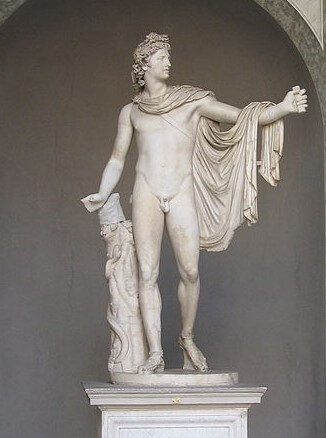
Apollo Belevedere was owned by Cardinal Giuliano della Rovere where it housed at his palace in Rome and later moved to the Vatican when he was elected as Pope Julius II and, there begins the hypocracy that I struggle with through this entire tour. Humble priest of the people living in a palace with important pieces of art…something is wrong with this picture. More on that later.
Belevedere Apollo is dated at 2nd Centrury AD and is probably a copy of an original bronze statue of 330-32BC. The interesting tidbit, The Apollo became one of the worlds most celebrated works of art from about 1755 and it is said that it was Napolean’s greatest prize amongst the loot that he seized from the Vatican. The Apollo was also the official logo of the Apollo 16 moon landing mission. You can visit your history books for the rest of the history!
Laocoon and His Sons
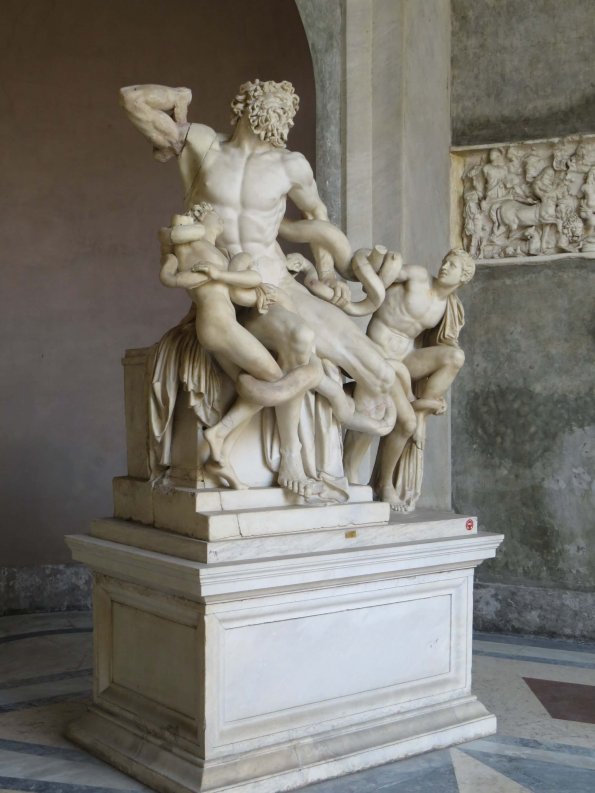
Apollo’s neighbour is a marble statue called “Laocoon and His Sons” that draws inspiration from Greek mythology of the Trojan War. It is dated somewhere between 40-30BC – pretty old! The sculpture depicts the moment that Laocoon realises that he and his sons were going killed by two giant serpents sent by Athena, the goddess of wisdom. The serpents were sent in retribution for threatening the plan of the Greeks to infiltrate the city of Troy using the famous Trojan Horse that would hide highly trained soldiers in its stomach. Identified as an important piece of art, humble priest Pope Julius II (same guy who owned Apollo Belevedere) bought the sculpture to be the centrepiece of the Statues Courtyard.
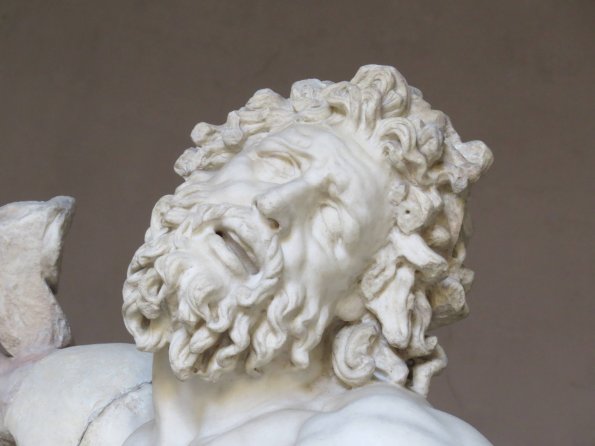
Now I’m not an art aficionado by any stretch of the imagination, but even I could see that the expression of pain, strength, the accuracy of anatomy and the ability to capture frantic motion is astounding. The expression on Laocoon’s face is dramatic. The expression of emotion is palpable and the detail is truly amazing. It’s worth a long look and multiple photos of every aspect of this piece of art.
The Belvedere Torso
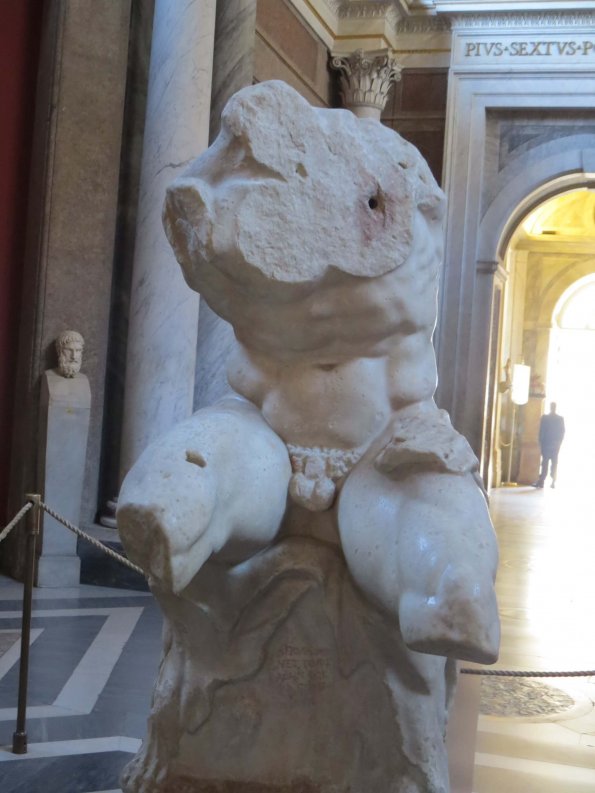
The Belvedere Torso somehow captured me. It is a fragment of a marble torso. No one is exactly sure who the torso depicts but the Vatican thinks it may be Ajax son of Telmon in the act of thinking about suicide. But know one is sure. Some think it is Heracles. Anyway the sculpture has been around since about 1st century BC (again know one is quite sure).
Now as I’ve said before I’m not an art afficianado and I didn’t ‘see’ the significance of the sculpture right away. It didn’t look that different to any other marble sculpture I’d seen and this one had pieces missing! But this sculpture had a profound effect on Michelangelo, Raphael and many other artists through the Renaissance and the Baroque period. Michelangelo was the torso’s biggest fan, using it as inspiration for his painting in the Sistine Chapel.
Michelangelo thought that the torso was a perfect example of the human form – the bones, the muscles and the veins. Something else captivated him. It was a work of art that was meant to be viewed from all sides rather than from the front like many other sculptures were made. If you have a look, the muscles across the Torso’s back are every bit anatomically correct as the front.
Bust and statues galore – only an art historian can do 70,000 works of art justice.
The Raphael Rooms
OK. Now I’m starting to feel tired. So many paintings. So many sculptures. Things were starting to blue into one artistic blur. I had to go on. Next stop was the Raphael Rooms in the Vatican palace.

Our tour guide brought the Raphael rooms to life with tales of scandal and fierce rivalry between Raphael and Michelangelo on his journey to becoming an renaissance masters. Without my guide I would’ve walked through the rooms in a detailed blur. I didn’t find the decoration particularly attractive, but I did understand the significance of the work and the stories behind each room were fascinating.
The Raphael Rooms are on the second floor of the Pontifical Palace and the apartment of Pope Julius II. The four reception rooms are covered in incredibly detailed frescos that are some of the most important frescos in the world.
Raphael Sanit from Urbino was a relatively unknown artist aged just 25 was asked by Pope Julius II to paint the Pope’s private apartments in 1508. He spent around ten years focused on painting frescos in Pope Julius’ apartments before he died at just 37 years old.
There are four to visit, the Sala di Constantino, the Stanza di Eliodoro, the Stanza della Segnatura, and the Stanza dell’Incendio del Borgo. The rooms were painted around the same time as the Sistine Chapel and are considered some of the most important paintings in the world.
Stanza della Sentura
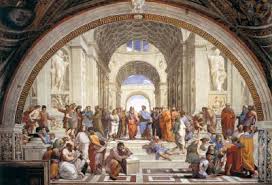
The most popular room is the Stanza della Sentura with a fresco called The school of Athens. I’m sure it’s popular for the humour in the painting. Almost cartoon like humour.
Plato and Aristotle are chatting – Plato has the face of Leonardo da Vinci. Heraclitus is leaning on a marble block writing on sheets of paper, he appears to be lost in his own thoughts – unhappy thoughts by the look of it. This Heraclitus has the face of Micheangelo – Raphael’s rival. Philosopher Diogenes lays on the stairs with Alexander the Great to his left. The philosopher Euclid is drawing with a compass but his face is Bramante – the architect of the Papal Palace. On the far right of the painting is a self-portrait of Raphael himself wearing a black beret.
The Vatican Gallery of the Tapestries
The Gallery of the Tapestries is on the way to the Sistine Chapel. In the anticipation of seeing the Chapel it is hard to slow down and take a look at the tapestries on your left and right, but you should.
The tapestries a simply a work of art. Imagine spending 9 years on one tapestry. The threads are silk, gold thread, silver thread and wool. The detail is so fine they look like a painting. Practical too, they used to hang them on the walls to insulate the walls against the heat of summer and the cold of winter.
The tapestries on the right depict scenes for Pope Urban VIII (Barberini) life.
The tapestries on the left depict the life of Christ. These are the most famous.
The most famous tapestry is the resurrection of Christ. Look at the eyes of Christ, like the Mona Lisa, they follow you from every angle. Imagine being able to achieve this using stitching.
Oh and take a look at the ceilings. The ceilings look like delicately carved scenes when in fact they are paintings using a technique call Chiaroscuro which uses painted shadows for a three dimensional effect.
Next stop the Sistine Chapel.
The Sistine Chapel
Did you know that 25,000 people visit the Sistine Chapel in one day, that’s five million each year? Would you like to be one of them? You should. It’s quite the experience.
This Sistine Chapel is the Pope’s private chapel in the Vatican. It has a dividing screen to separate the pontiff from pilgrims should they be in there at the same time. It is also where the election of a new pope takes place behind a bolted door by The College of the Cardinals. It’s been that way since 1870.

The Sistine Chapel is covered in the most famous frescos in the world painted by the most famous renaissance painters in the world. Botticelli painted the fresco along the two long walls that tells the story of Moses on one side and the story of Christ on the other side. Michelangelo painted the ceiling that depict the stories from the Book Of Genesis from the Creation to the story of Noah and The Last Judgement on the alter wall.
Michelangelo was the first to paint an image of God. He portrayed him as a muscular man with long white hair and beard similar to how many people think of God today.
Groups are ushered one by one. There’s a hum of people trying to whisper to each other in a holy place where there is not to be any speaking. Then out of the blue across a loud speaker you hear “SILIENZO” followed by “QUIET PLEASE!”. Not just once but what seems like every 30 seconds! So annoying for a place of quiet!











